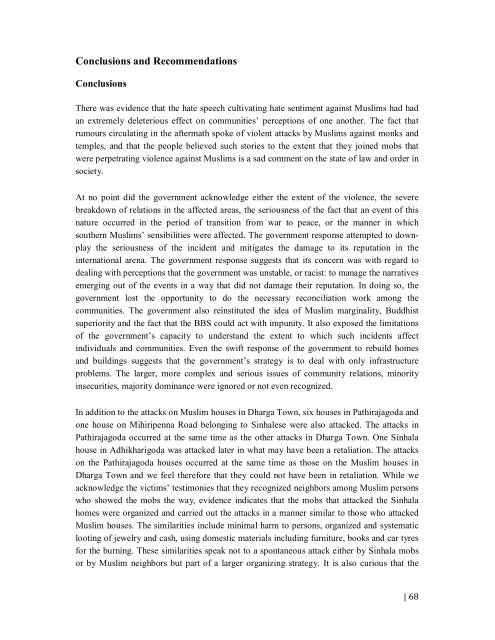You also want an ePaper? Increase the reach of your titles
YUMPU automatically turns print PDFs into web optimized ePapers that Google loves.
Conclusions and Recommendations<br />
Conclusions<br />
There was evidence that the hate speech cultivating hate sentiment against Muslims had had<br />
an extremely deleterious effect on communities’ perceptions of one another. The fact that<br />
rumours circulating in the aftermath spoke of violent attacks by Muslims against monks and<br />
temples, and that the people believed such stories to the extent that they joined mobs that<br />
were perpetrating violence against Muslims is a sad comment on the state of law and order in<br />
society.<br />
At no point did the government acknowledge either the extent of the violence, the severe<br />
breakdown of relations in the affected areas, the seriousness of the fact that an event of this<br />
nature occurred in the period of transition from war to peace, or the manner in which<br />
southern Muslims’ sensibilities were affected. The government response attempted to downplay<br />
the seriousness of the incident and mitigates the damage to its reputation in the<br />
international arena. The government response suggests that its concern was with regard to<br />
dealing with perceptions that the government was unstable, or racist: to manage the narratives<br />
emerging out of the events in a way that did not damage their reputation. In doing so, the<br />
government lost the opportunity to do the necessary reconciliation work among the<br />
communities. The government also reinstituted the idea of Muslim marginality, Buddhist<br />
superiority and the fact that the BBS could act with impunity. It also exposed the limitations<br />
of the government’s capacity to understand the extent to which such incidents affect<br />
individuals and communities. Even the swift response of the government to rebuild homes<br />
and buildings suggests that the government’s strategy is to deal with only infrastructure<br />
problems. The larger, more complex and serious issues of community relations, minority<br />
insecurities, majority dominance were ignored or not even recognized.<br />
In addition to the attacks on Muslim houses in Dharga Town, six houses in Pathirajagoda and<br />
one house on Mihiripenna Road belonging to Sinhalese were also attacked. The attacks in<br />
Pathirajagoda occurred at the same time as the other attacks in Dharga Town. One Sinhala<br />
house in Adhikharigoda was attacked later in what may have been a retaliation. The attacks<br />
on the Pathirajagoda houses occurred at the same time as those on the Muslim houses in<br />
Dharga Town and we feel therefore that they could not have been in retaliation. While we<br />
acknowledge the victims’ testimonies that they recognized neighbors among Muslim persons<br />
who showed the mobs the way, evidence indicates that the mobs that attacked the Sinhala<br />
homes were organized and carried out the attacks in a manner similar to those who attacked<br />
Muslim houses. The similarities include minimal harm to persons, organized and systematic<br />
looting of jewelry and cash, using domestic materials including furniture, books and car tyres<br />
for the burning. These similarities speak not to a spontaneous attack either by Sinhala mobs<br />
or by Muslim neighbors but part of a larger organizing strategy. It is also curious that the<br />
| 68




